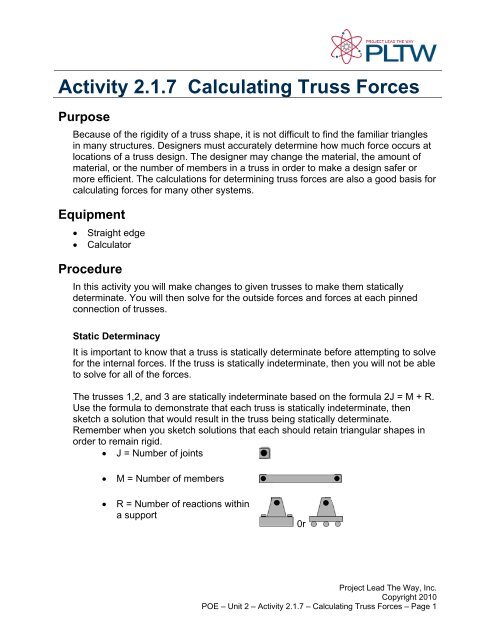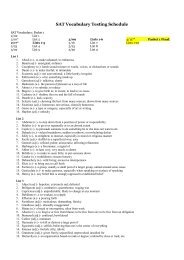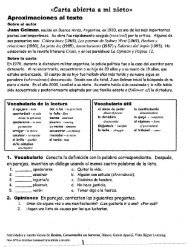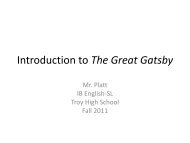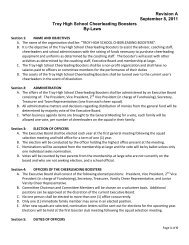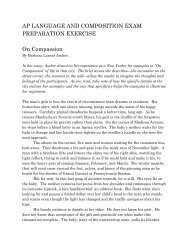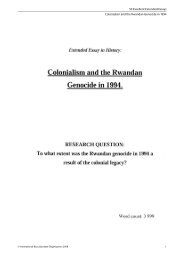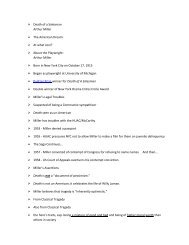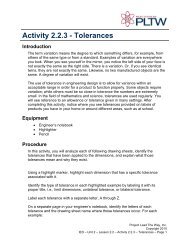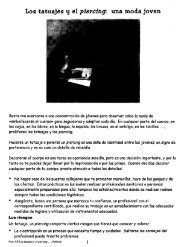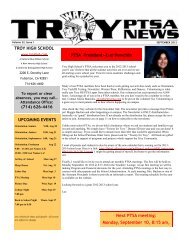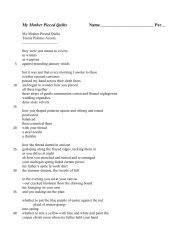Activity 2.1.7 Calculating Truss Forces Purpose - Troy High School
Activity 2.1.7 Calculating Truss Forces Purpose - Troy High School
Activity 2.1.7 Calculating Truss Forces Purpose - Troy High School
- No tags were found...
Create successful ePaper yourself
Turn your PDF publications into a flip-book with our unique Google optimized e-Paper software.
<strong>Activity</strong> <strong>2.1.7</strong> <strong>Calculating</strong> <strong>Truss</strong> <strong>Forces</strong><strong>Purpose</strong>Because of the rigidity of a truss shape, it is not difficult to find the familiar trianglesin many structures. Designers must accurately determine how much force occurs atlocations of a truss design. The designer may change the material, the amount ofmaterial, or the number of members in a truss in order to make a design safer ormore efficient. The calculations for determining truss forces are also a good basis forcalculating forces for many other systems.EquipmentStraight edgeCalculatorProcedureIn this activity you will make changes to given trusses to make them staticallydeterminate. You will then solve for the outside forces and forces at each pinnedconnection of trusses.Static DeterminacyIt is important to know that a truss is statically determinate before attempting to solvefor the internal forces. If the truss is statically indeterminate, then you will not be ableto solve for all of the forces.The trusses 1,2, and 3 are statically indeterminate based on the formula 2J = M + R.Use the formula to demonstrate that each truss is statically indeterminate, thensketch a solution that would result in the truss being statically determinate.Remember when you sketch solutions that each should retain triangular shapes inorder to remain rigid. J = Number of jointsM = Number of membersR = Number of reactions withina support0rProject Lead The Way, Inc.Copyright 2010POE – Unit 2 – <strong>Activity</strong> <strong>2.1.7</strong> – <strong>Calculating</strong> <strong>Truss</strong> <strong>Forces</strong> – Page 1
1.2.3.Solving Statically Determinate <strong>Truss</strong>esUse the method below to calculate the forces occurring at each pinned connection.Draw a free body diagram of the entire truss. Label applied forces, knowndimensions, and replace supports with labeled reaction forces.Sum the moments occurring about one or more pinned support(s) to solve forreaction forces at supports. There may be occasions when this will not solveany unknown reaction forces. If that happens, move to the next step.Use method of joints to create free body diagrams for each joint to solve forall of the forces acting at that joint.Assume measurements contain 3 significant digits.Project Lead The Way, Inc.Copyright 2010POE – Unit 2 – <strong>Activity</strong> <strong>2.1.7</strong> – <strong>Calculating</strong> <strong>Truss</strong> <strong>Forces</strong> – Page 2
4.5. Optional (Extra Credit)Conclusion1. What is the significance of including roller connections rather than pinnedconnections?2. How does the triangle shape make a truss rigid?Project Lead The Way, Inc.Copyright 2010POE – Unit 2 – <strong>Activity</strong> <strong>2.1.7</strong> – <strong>Calculating</strong> <strong>Truss</strong> <strong>Forces</strong> – Page 3


